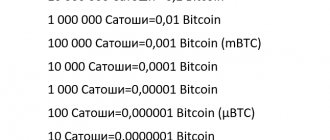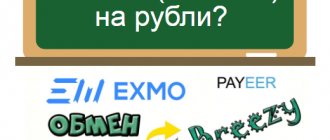Just as a dollar is divided into 100 cents, and a ruble is divided into 100 kopecks, Bitcoin is divided into 100 million parts, which are called “satoshi”. The answer to the question “how many Satoshi are in a Bitcoin” is 100 million. This figure is unchanged, and 1 Bitcoin in Satoshi costs 100,000,000.
Therefore, Bitcoin consists of two “official” units, one of which is called “Satoshi”, and the second is Bitcoin, its exchange abbreviation (ticker) is BTC.
Other names for “parts” of Bitcoin are also common among cryptocurrency users. For example, one ten-millionth of a Bitcoin (10 satoshi) is called a finney in honor of the scientist Hal Finney, who received the first BTC transaction.
100 Satoshi (one millionth of a Bitcoin) is called a “micro Bitcoin”, μBTC, and 100,000 Satoshi (1 thousandth of a Bitcoin) is called a “milli Bitcoin” mBTC.
Satoshi - what is it in simple words
The question arises: “Why does Bitcoin need to be divided into as many as 100 million Satoshi, when, for example, the dollar or ruble is divided into only 100 parts?” The answer lies in the nature of Bitcoin's economics, which accepts only a few hundred satoshi as the minimum reward for work. 1 Satoshi represents one 100 millionth of a Bitcoin. In mathematical form it looks like this – 0.00000001 BTC. In the context of Bitcoin, it means the same as a cent in a dollar or a kopeck in a ruble. It is the smallest indivisible unit of Bitcoin.
The cost of one bitcoin is a considerable amount and amounts to several tens of thousands of dollars. If you have 1 BTC on your wallet account and need to send, for example, one thousandth of the available unit, the operation is carried out in satoshi. This means that you can make a transfer in the system of any amount. When transferring, the system provides a commission for completing the transaction.
What can you spend it on and where can you store it?
Satoshi is a cryptocurrency. Yes, they are a component of Bitcoin, but they also have a certain value. You can spend them on any purchases, payments for services – on anything that involves the ability to pay with cryptocurrency. This could be obtaining access to the forum, paying for a lawyer, or buying a cup of coffee.
Satoshi is a component of Bitcoin, and Bitcoin is “digital gold” - the most popular cryptocurrency. This means that Satoshi is the most liquid means of payment on the cryptocurrency market. Having these coins on your balance, you don’t have to be afraid that they will refuse to accept them, asking you to pay with another cryptocurrency.
Satoshi are stored on any Bitcoin-adapted wallet. All wallets are divided into several types:
- Wallets for cold storage (without Internet access). Among them we can highlight the wallet – Bitcoin Core;
- Wallets in the form of an application for laptops or personal computers. The most popular are Electrum, Exodus and Jaxx;
- Online wallets that are installed in the browser like a regular extension. There are a great variety of such wallets, among them you can choose: Blockchain.info, Cryptopay, Coinbase.com, Cryptonator and a wallet from Webmoney - WMX;
- Wallets for smartphones. They are divided into categories into applications for Android and iOS;
- Hardware wallets are devices for storing encrypted information. Outwardly, they are similar to regular flash drives;
- Paper wallets. In this form, information is simply written down on a piece of paper.
Why is it called Satoshi
Bitcoin only had two official units.
- Bitcoin is called BTC for short.
- Satoshi is briefly called Sat and the plural form of Satoshi, which is often abbreviated, is called Sats.
Satoshi (0.00000001 ฿) received its name in honor of the author of Bitcoin, Satoshi Nakamoto. In addition to Satoshi, many in the Bitcoin community have suggested that the second smallest denomination of Bitcoin should be called “Finney”.
1 Phinney is equal to 10 Satoshi, which will be equal to 0.00000010 BTC.
The name Finney is a reference to Hal Finney, a computer scientist who was an early Bitcoin user who received the first BTC transaction from its founder Satoshi Nakamoto.
Satoshis are officially the smallest unit, there is a "millisatoshi" which is one thousandth of a Satoshi or one hundred billionths of one Bitcoin.
Bitcoin - Units of measurement are usually expressed in decimals like BTC, mBTC, µBTC, etc. Due to the high value, a transaction involving a whole Bitcoin is not that common, and you may be wondering what to call 0.01 BTC or 0.001 BTC.
Incomprehensible moments
Why do some people claim that only rich people can buy Bitcoin because of its high price? This is probably caused by two factors.
Most skeptics are either those who do not understand the technology, or those who have only a superficial understanding and are not willing to delve into the issue. These people tend to have a more traditional financial mindset and are very suspicious of cryptocurrencies.
Another likely source of misunderstanding is that many have compared crypto assets to stocks. Most stock brokers will not allow you to buy a fraction of a single stock. You are unlikely to buy less than a whole share, except perhaps by collaborating with a friend or through dividend reinvestment programs.
Since cryptocurrencies exist entirely outside of banks and other financial institutions, they are not subject to such regulations. Therefore, those who want to buy digital currency can purchase them for any amount.
Other cryptocurrencies allow even more private shares of a single coin.
How to convert satoshi to rubles
So, at the time of making the transfer and calculating satoshi in rubles and dollars, it is necessary to determine the rate of 1 bitcoin. If 1 BTC costs 60,000 dollars or 4,440,000 rubles (rate 1 dollar – 74 rubles), then 1 satoshi will cost 0.0444 rubles, and 100 satoshi will cost 4.44 rubles. Taking the same rate as a basis and calculating the Satoshi rate in dollars, the following will be obtained: 1 Satoshi is equal to $0.00060, and 10,000 Satoshi is equal to $6.
1 satoshi in rubles costs 4 kopecks. This is the reason for establishing acceptable values for making a transfer from 10,000 satoshi. Exchange transactions of small amounts are carried out similarly to the amounts of whole Bitcoin coins, that is, for all electronic and real currencies. This could be WebMoney, QIWI, bank transfer, plastic card.
Many exchanges and cryptocurrency exchange offices announce the rates of Satoshi and Bitcoin separately so that users and clients can conveniently use the service and quickly calculate the exchange rate.
How many satoshis are there in 1 bitcoin?
In traditional currencies, the monetary unit is usually divided into one hundred parts, but in crypto things are a little different. To collect 1 Bitcoin in Satoshi you need to have one hundred million digital kopecks. That is, 1 BTC = 100,000,000 satoshi . By the way, there is no generally accepted abbreviation for digital shares of Bitcoin; sometimes they are designated as Sat or simply S , but often the full name is written. But larger digital pennies are called differently. Remember:
| Unit | Reduction | Cost in Satoshi | Decimal (BTC) |
| Bitcoin | BTC | 100000000 | 1 ? |
| Deci Bitcoin | dBTC | 10000000 | 0.10000000 ? |
| Centi Bitcoin (Bitcent) | cBTC | 1000000 | 0.01000000 ? |
| Milli Bitcoin | mBTC | 100000 | 0.00100000 ? |
| — | — | 10000 | 0.00010000 ? |
| Micro Bitcoin (1 Bit) | ?BTC | 100 | 0.00000100 ? |
| Finney | — | 10 | 0.00000010 ? |
| Satoshi | Sat | 1 | 0.00000001 ? |
The smallest share is called satoshi after the unknown genius who created the first coin on the blockchain. But the first programmer who became interested in the idea and joined the project was called Hal Finney. Frankly, without it, Bitcoin might have been lost. Although, of course, another person, for example Vitalik Buterin, could later come up with something similar.
However, not everyone considers Bitcoin a concept born spontaneously, a challenge of human genius to the absurdities of the global financial system. For example, Kaspersky Lab is confident that the first cryptocurrency was invented by the CIA to simplify the transfer of funds to foreign agents. But let's return to our satoshi.
Where is Satoshi used?
Satoshi became widespread on Bitcoin faucets - services that provide the opportunity to earn some coins simply for being on their website.
But they won’t pay much “just for visiting” and therefore you can get tens and, rarely, hundreds of satoshis in one visit. If bonuses were indicated in fractions of Bitcoin, then it would be difficult for people to understand how much they would receive in the end (you’ll get tired of counting the zeros after the decimal point).
Profitable faucets where they give out satoshi:
- FreeBitcoin
- Free Dogecoin
- Bonus Bitcoin
- BitFun
- Moon Bitcoin
- Moon Dogecoin
- Moon Litecoin
- Moon Dashcoin
- Moon Cash
- Daily Free Bits
The best online games for satoshi
A less popular, but profitable way to earn coins is browser games with prizes in Satoshi. There are two options for generating income - with and without investments.
If a game requires a top-up, think carefully before paying and carefully read the reviews about it. You are risking your money.
The earning algorithm is simple. You receive it for free or buy satoshi, then use it to play. If you win, the amount increases; if you lose, you lose the bet amount.
Popular games:
| Name | Description |
| Primedice | Upon registration, the user receives 150 satoshi. Afterwards, they can be doubled or lost. The interface is clear, the gameplay is simple. |
| Bitkong | A popular game with withdrawal of money, without investments. The essence of the game is to choose one of three cells and not get into an empty one. After registration, a bonus is credited to your account, and a faucet with free Satoshi is also available. |
| BoxBitcoin | There are 10 chests with prizes to choose from. You need to choose one. Earning money is possible without investing your own funds. |
| FreeBitcoin | You can get Satoshi for free, after which you have the opportunity to win or lose using the high-low game. |
| Chopcoin | A dynamic game, the goal is to grow a ball larger than others by absorbing smaller balls. You can play without investment. |
| Stake | A selection of gambling games on Satoshi. There is a faucet, which makes it possible to play without investment. A choice of Russian language is available at the bottom of the site. |
| Tomygame | The plot is based on the cartoon Tom and Jerry, without investments. |
Of course, these are not all services with which you can earn Satoshi from games, but you need to be careful when making money on such sites. Often their life expectancy is short, and not everyone has time to withdraw their money. For example, the game celsel used to be popular, but now the site is not working, and players who did not manage to withdraw funds were left with nothing.
How many coins did Nakamoto mine?
This question has probably been discussed even more often than the question of who Satoshi Nakamoto is. There are some interesting studies, but there is also no evidence or refutation of this theory. However, according to one very slim version, Satoshi Nakamoto managed to mine more than a million BTC coins.
Researcher Sergio Demian Lerner used the ExtraNonce field gain technique to prove his findings.
BTC mining profitability statistics at the beginning of the blockchain
Larner was able to determine and prove that at the very beginning of the block chain, only one computer was engaged in mining. From the Genesis block to block #36288, there was only one machine mining on the network. This investigation coincides with the previous one, which also claims that it was this computer that mined the first 1,148,800 BTC coins.
Earn satoshi on your phone
Manufacturers of applications for IOS and Android keep up with trends and also release programs that allow you to earn cryptocurrency on your phone. At the same time, the software is varied.
Spoiler: you won’t be able to earn a lot using mobile apps. All you can count on is a couple of dollars for a decent amount of time spent.
Many developments are the activities of scammers who make money from advertising (and sometimes user investments) and do not pay any money. We tried to collect the best applications based on participant reviews and overall ratings. The collected programs will give you an understanding of how to earn Satoshi on Android.
| Application Name | Description |
| MinerGate | Application of a famous mining pool site. Allows you to mine cryptocurrency using your mobile phone. At the same time, the user can chat with other participants, monitor prices, and buy cloud capacity to increase profits. |
| Hashflare | Hashflare allows you to connect to cloud cryptocurrency mining using your mobile phone. Capacity for production must be purchased (from $2.2). In addition to Bitcoin, you can earn Ethereum, Zcash and Litecoin. According to the developers, all investments will pay off in six months. |
| Storm Play | A faucet that allows you to earn satoshi. User reviews are positive, apparently, they pay out the money they earn. One of the disadvantages is the English-language interface. |
| TabTrader | A trading terminal with which the user can buy cryptocurrency for trading on many exchanges. |
| Kryptonator | Multi-currency wallet for purchasing and storing cryptocurrencies. Depositing and withdrawing money is easy. Russian-language interface. |
| ICO Alarm | Allows you to monitor the market for ICO investments in real time. The mobile application will be useful to investors and anyone interested in blockchain, cryptocurrency and tokens. |
Of course, Play Market showcases provide more variety. But you need to understand that many do not meet the requirements. And the main complaint is the lack of payments. Read user reviews carefully (20–30 reviews, no advertising of referral links or codes). Afterwards, you will understand that not all Android applications for collecting crypto coins are worth even a little attention.
How to withdraw Satoshi and where
To withdraw Satoshi from an exchange or faucet, you will need a Bitcoin wallet. There are 2 options for creating it: downloading the official client to your computer and registering the wallet online.
The official client or “cold wallet” is the safest option for storing coins. All keys will be located on the user's computer, as will the complete block registry starting in 2009. The owner of a cold wallet does not have to worry about the safety of his bitcoins, unless he himself loses his laptop or computer hard drive. For such cases, it is recommended to create backup copies.
A less secure, but easier option for storing Satoshi is an online wallet. To create a wallet, you need to register on the resource and receive a unique key. The online wallet address can then be used to store and transfer coins. There is no need to store the blockchain on your computer (and it weighs about 150 GB), but the service may close and stop working, as has happened many times with online wallet sites. It will be technically impossible to return lost funds.
How to buy 1 Satoshi?
Since Bitcoin transactions are subject to a fee in Satoshi, it is not possible to carry out such a small transaction. Although, in principle, miners can process a cryptocurrency transfer for free, no one will send you such an amount. And how would you pay for it? The transfer of 0.81256791 kopecks will not be made by any bank or payment network; the client will simply be considered crazy. But exactly how much is 1 satoshi in rubles . Most crypto exchanges do not service transactions below one millibitcoin.
So, if you have regular money or another crypto, and you need Satoshi, prepare a more or less decent amount. By the way, it will be best and more convenient for you to buy on Binance; it is a reliable crypto platform with good liquidity.
There is an additional fee for transactions on any exchange or exchanger, but if you want to negotiate directly with the counterparty, Binance has a P2P branch. There you can buy yourself a few millibitcoins without commission. For a complete list of exchanges, see the services coinecko and coinmarketcap .
Calculator for calculating the cost online
Converters that help convert Satoshi into bitcoins and other currencies have also been created on other platforms in the blockchain industry, for example, on satoshitobitcoin.ru or cryptolot.ru.
How to exchange Satoshi for Rubles
Knowing what satoshi are, they can be exchanged for rubles. The main thing is to figure out where and how to do it.
Special resources that act as exchangers save:
- Exchange services . These are virtual units that exchange cryptocurrency for rubles. Their peculiarity is the use of their own rate, which does not always coincide with the official rate. More often, it differs greatly from the rate applied on the exchange, and not in favor of the person who is trying to make the exchange.
- Exchange. This is the safest, fastest and fairest way to exchange cryptocurrency for fiat money. Most of them are English-language, but given that we are interested in exchanging for rubles, it would be logical to find a Russian-language resource. So far the largest of them is BTC-E (it has Russian-language technical support). This service has an increased level of security, which attracts users to it.
- Transactions with cryptocurrency holders. The least secure way to complete a transaction is by transferring money from person to person. The system is anonymous, and if a person gets hooked by scammers, he will never get his money back. But there is no commission here. You can find a potential partner on specialized forums.
But it’s better not to take risks and use protected transactions. Although even in the case of cooperation with certain exchanges or other resources, one must be careful.
Satoshi Nakamoto - studio photo
The emergence of cryptocurrency can be compared in terms of the scale of the event with the emergence of the Internet itself. Both events literally turned our lives upside down. But unlike the Internet (where its creator is known and you can easily find Tim Berners-Lee’s photo online), the creator of the world’s first cryptocurrency still remains completely incognito.
Only the pseudonym of this person is known - Satoshi Nakamoto . The name in Russian is sometimes pronounced as Satoshi, but still more often they use what has already become familiar - Satoshi. So who was he (and is)? Science doesn’t know this yet.
Although, from the history of blockchain operations (and all transactions for the entire existence of the cryptocurrency are stored there), it is known for sure that Nakamoto (or a group of people acting under a common nickname) mined more than a million bitcoins (over ten lard of greenbacks at the current rate). It is not known exactly what he did with them—sold them or still owns them.
On the topic of who this Satoshi Nakamoto is, you can find quite a lot of guesses on the Internet (even to the point that he is none other than Mavrodi). Journalistic investigations were carried out on this matter, books were written, attempts were made to identify the author by publications and manner of communication (the person under this pseudonym was an active participant in communication among those who built the Bitcoin network). It is still not clear who exactly performed under the name Satoshi Nakamoto.
See for yourself. In October 2008, Nakamoto wrote an article about the use of cryptography to create a reliable money exchange system without the participation of a third party (a transaction guarantor, such as a bank). Already at the beginning of 2009, the first cryptocurrency system was launched and there was an active discussion of the software used and the solution of a number of issues through the network with its participation.
However, already in 2011, messages from Nakamoto stopped appearing and the entire development of Bitcoin continued without his participation (he transferred the rights to the bitcoin.org domain to one of the active participants in the development). That's it, I don't hear from him anymore. Why? Doesn't he really want worldwide fame?











